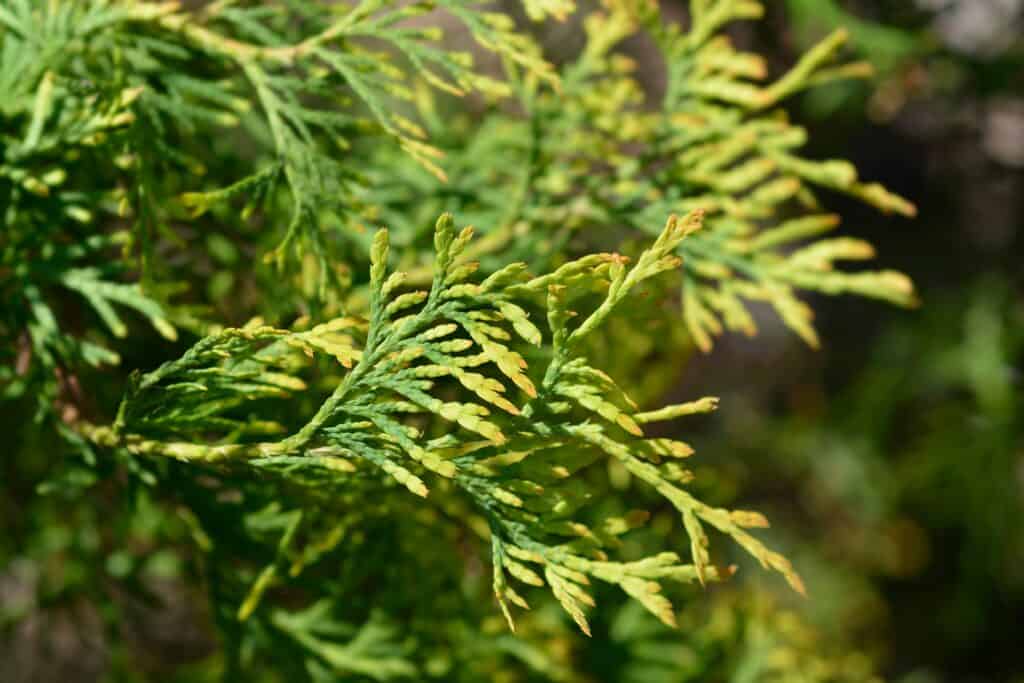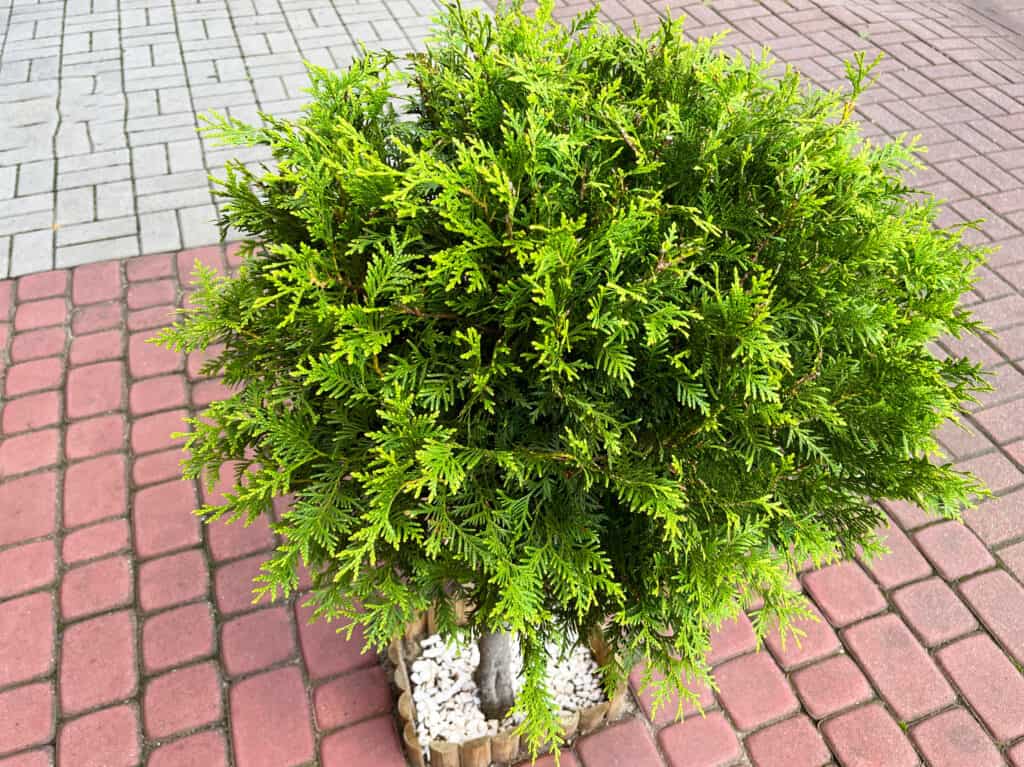Do you know what the large green bush that’s always used for hedges and grows into a tall, slender, bushy tree is called?
Although you may not recognize the name American Arborvitae, you definitely know this plant!
There are many different varieties of this tree, each with a slightly different look. This is why we see the American Arborvitae grown as a hedge, sometimes as a single tree, or as dwarf varieties spotted throughout the landscaping.
Emerald Green is one of these varieties and thus belongs to the category of trees called American Arborvitae. Still, not all American Arborvitaes are Emerald Green. In this article, we’ll explore everything you need to know about American Arborvitae vs. Emerald Green trees!
American Arborvitae vs. Emerald Green at a Glance
| American Arborvitae | Emerald Green | |
|---|---|---|
| Bontanical Name | Thuja occidentalis | Thuja occidentalis ‘Smaragd’ |
| Looks | Green, shrubby foliage; can be a small or large bush or a slender tree | Bright green foliage; grows upward in a pyramidal shape |
| Size | Ranges from 2′ to 40′ tall by 2′ to 15′ wide | 12′ to 14′ tall by 3′ to 4′ wide |
| Growing Zones | 2 to 7 | 3 to 7 |
| Growing | Low-maintenance landscaping plant; full sun and low water needs | Low-maintenance landscaping plant; full sun and low water needs |
About American Arborvitae Trees
American Arborvitae trees are native to North America and can grow all over the continent. Over the years, tons of varieties of this tree have naturally spawned. Because it’s such an excellent choice for landscaping, American Arborvitae has been specially bred.
American Arborvitae trees are also often called Northern White Cedar, Eastern White Cedar, or Swamp Cedar, depending on what part of the U.S. you’re in.
These trees are super popular for yards because they’re easy to grow and keep their form all year. They’re also easy to prune and trim, often cut into spirals or used in landscaping as natural fences.
About Emerald Green Trees
Emerald Green trees are a cultivar of American Arborvitae, bred in Denmark. “Smaragd” is Danish for Emerald, as seen in its scientific botanical name. This tree is sometimes called Emerald Green Thuja, which comes from its botanical name.
Emerald Green is one of the most famous American Arborvitae types. People usually know Emerald Green trees but seldom realize they are the same as American Arborvitae.
Known for its compact size and as a semi-dwarf cultivar of American Arborvitae, homeowners often use Emerald Green for hedges.
American Arborvitae vs. Emerald Green: Looks

American Arborvitae trees generally have green foliage covering the whole tree, so neither the trunk nor branches are visible.
©Nahhana/Shutterstock.com
Since there are so many American Arborvitae trees, the appearance can vary depending on which variety you’re looking at. Many cultivars are dwarf varieties and look like small bushes, while others look like huge green pillars.
American Arborvitae trees generally have green foliage covering the whole tree, so neither the trunk nor branches are visible. The foliage is flat and spread out and pretty shaggy if not trimmed.
Some cultivars have more yellow-green foliage, while others have an orange or red tint. American Arborvitae trees keep their foliage throughout the winter, although some change colors with fall and winter.
The Emerald Green has- as you might’ve guessed- bright emerald-green foliage, which becomes green-yellow once the temperatures drop.
Emerald Green trees grow upright and are much taller than they are wide. However, they’re stout when they’re younger before they begin to grow tall. Mature trees have pyramidal shapes.
Size
American Arborvitae can also be found in a large range of sizes, with the smallest ones being one to two feet tall and the largest ones over 40 feet!
Of course, the height and width depend on the specific type, but also the age of the tree. American Arborvitae trees grow fairly quickly and bloom into tall trees.
Emerald Green trees grow between 12 and 14 feet tall and 3 to 4 feet wide.
Growing Zones

Emerald green arborvitae is a slow-growing tree that only achieves a maximum growth of 12 inches per year.
©iStock.com/Aliaksandr Yarmashchuk
American Arborvitae trees can grow in zones 2 to 7, though the specific zones will depend on the variety. American Arborvitae trees are very hardy and can handle intense winters and cold temperatures.
Some varieties of American Arborvitae are more tolerant to warm weather than others. If you live in the south, check which varieties grow best in your region.
Emerald Green grows in zones 3 to 7, so it’s slightly less hardy but can still grow in most parts of the U.S.
Growing Needs
Regardless of the variety, American Arborvitae trees are incredibly low maintenance and can adapt to various situations. They’re also typically disease free and don’t have any problems with pests, despite being almost exclusively grown outdoors.
These trees are ideal for landscaping and can be grown in almost any space. They’re top choices for hedges, garden borders, or creating a windbreak. Many varieties can also be grown on patios in containers!
American Arborvitae trees don’t need to be pruned. However, they often are when grown for landscaping. The foliage stays on the trees all year long, providing a fresh green color in the winter when most trees lack color!
Many varieties of American Arborvitae are deer resistant, but not all are. So, if you’re concerned about this, it’s best to look into the specific information for each variety.
American Arborvitae vs. Emerald Green: Soil Type
All American Arborvitae have the same preferences for soil composition, but most are also very adaptable. American Arborvitae can generally tolerate chalky, loam, sandy, or clay soil types and a range of soil pH as long as it’s not incredibly acidic.
The ideal soil type for American Arborvitae is well-draining soil that allows excess water to leave but still retains some moisture. It’s the same for Emerald Green trees. These trees like to have consistently moist soil and can grow well along ponds or in boggy soil.
Watering
An American Arborvitae usually doesn’t need to be watered when growing outdoors and can pull from moisture in the soil. These trees do particularly well in areas with frequent rains and humidity.
American Arborvitae does not thrive in dry environments. If growing in dry climates, it will need to be watered weekly. However, the Emerald Green is more tolerant to dry spells than most varieties.
American Arborvitae vs. Emerald Green: Sunlight Needs
Emerald Green trees are similar to all American Arborvitae trees when it comes to sunlight: they’ll take as much as possible. American Arborvitae trees love being in full sun and can never get enough.
If you live further south and have scorching summers, it may be helpful if your American Arborvitae gets a bit of shade.
However, these trees can handle a lot and are typically better off in full sun than too much shade, which will make them droop and lose their shape.
Hedges Galore!
As mentioned above, American Arborvitae is famous for creating hedges and is often chosen for various landscaping needs. However, some people simply use them to embellish their land.
The dwarf varieties are great for small yards, filling between plants or dotted around your landscape. The taller, tree-like varieties are elegant and are impressive additions to any yard.
There are so many ways you can grow and style the American Arborvitae. With such a wide variety, there’s something for everyone!
Up Next
- Arborvitae vs Juniper: What Are The Differences?
- Brandon Arborvitae vs. Emerald Green
- Degroot’s Spire vs. Emerald Green Arborvitae
- Pyramidal Arborvitae vs. Emerald Green: What’s the Difference?
The photo featured at the top of this post is © iStock.com/Aliaksandr Yarmashchuk
Sources
- Gardenia / Accessed November 5, 2022
- Full Speed A Hedge / Accessed November 5, 2022
- Bustling Nest / Accessed November 5, 2022
- Long Fellows Garden / Accessed November 5, 2022
- Almanac / Accessed November 5, 2022
Thank you for reading! Have some feedback for us? Contact the AZ Animals editorial team.







